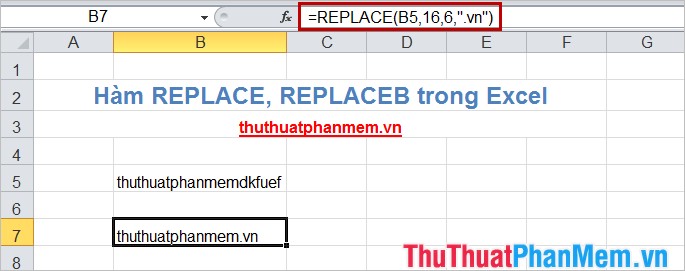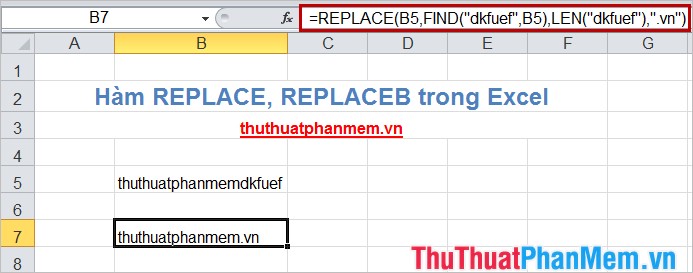REPLACE and REPLACEB (replace part of the input text string) in Excel
When you need to search for a string in a text you will use the FIND () function, but to search and replace the new string directly, you need to use the REPLACE () or REPLACEB () function. If you do not know the syntax and usage of the two search and replace functions REPLACE (), REPLACEB (), you should follow the article below.

The article presents syntax and usage of REPLACE (), REPLACEB () in Excel.
Description
The REPLACE () and REPLACEB () functions are both functions that replace a part of the input text string.
The REPLACE () function helps you replace part of the input text string with another text string, based on the number of characters you specify. This function is used in languages that use single-byte encoding (SBCS). The REPLACE () function always counts each character as 1 whether it's a single byte or double byte regardless of the default language.
The REPLACEB () function helps you replace one part of the input text string with another, based on the number of bytes specified. Functions for languages that use double-byte encoding (DBCS). The REPLACEB () function counts each double-byte character as 2 when you use the default language, DBCS, otherwise the function will count each character as 1.
Syntax
= REPLACE (old_text, start_num, num_chars, new_text)
= REPLACEB (old_text, start_num, num_bytes, new_text)
Inside:
- old_text: the text string you need to replace some characters.
- start_num: position of the character in the text string to be replaced, starting from the left.
- num_chars: the number of characters in old_text that you want to replace with the new string.
- num_bytes: the number of bytes in the old_text string that you want to replace with the new string.
- new_text: is the new text string that you want to replace the characters in the old_text string.
For example
- Replace 6 characters starting from the 16th character in the string in cell B5 with the new string that is .vn

- In addition, instead of counting the starting characters or the number of characters to replace, you can use the FIND () or SEARCH () function to determine the start position (start_num) and use the LEN function. () to determine the number of characters of the string to be replaced (num_chars).
= REPLACE (B5, FIND ("dkfuef", B5), LEN ("dkfuef"), ". Vn")

So you know how to use the REPLACE () and REPLACEB () functions in Excel, you should combine with other functions to achieve the best effect. Good luck!
You should read it
- Complete guide to Excel 2016 (Part 10): Use the Find and Replace function
- How to find and replace text in Chrome and Firefox
- Difference between REPLACE and SUBSTITUTE in Microsoft Excel
- Instructions for using the Find and Replace functions in Excel
- REPLACE function in SQL Server
- How to replace a string with MySQL Query
- Tutorial for Word 2016 (Part 5): Use Find and Replace
- LEN () and LENB () functions in Excel
May be interested
- How to split strings in Excel
 in excel when working with character strings, there are many cases where it is necessary to split a string to use the data, but the amount of data needs to be separated quite large, if merely manually doing it takes a lot of time and effort. strength. the following article guides to
in excel when working with character strings, there are many cases where it is necessary to split a string to use the data, but the amount of data needs to be separated quite large, if merely manually doing it takes a lot of time and effort. strength. the following article guides to - The MID function in Excel, how to use the MID function, and examples
 the mid function in excel, how to use the mid function, and examples. the mid function in excel is a function of the text function group, you use the mid function if you want to cut the string in the middle of the text string when processing the string. if you do not know or do not understand the mid function, then you
the mid function in excel, how to use the mid function, and examples. the mid function in excel is a function of the text function group, you use the mid function if you want to cut the string in the middle of the text string when processing the string. if you do not know or do not understand the mid function, then you - How to speed up input in Excel
 instructions how to speed up typing in excel to speed up typing, you can use abbreviations instead of what you need to type. choose words, phrases that appear frequently or how often you use them to replace them with abbreviations
instructions how to speed up typing in excel to speed up typing, you can use abbreviations instead of what you need to type. choose words, phrases that appear frequently or how often you use them to replace them with abbreviations - Separate text from strings in Excel, for example, and how to do it
 separate text from strings in excel, for example, and how to do it. in excel, there are 3 basic functions that help you separate text from strings in excel: left, right, mid. if you are looking to separate words from a string, please refer to the article
separate text from strings in excel, for example, and how to do it. in excel, there are 3 basic functions that help you separate text from strings in excel: left, right, mid. if you are looking to separate words from a string, please refer to the article - How to use MID functions to get strings in Excel
 mid function in excel is a function that takes the middle character string corresponding to the value that the user requires to perform.
mid function in excel is a function that takes the middle character string corresponding to the value that the user requires to perform. - The LEFT function, how to use the left-hand string cutting function in Excel
 the left function in excel is used to trim the left string of characters in data parameters.
the left function in excel is used to trim the left string of characters in data parameters. - The function takes a string in Excel
 the function takes a string in excel. the function to get the string in excel includes 3 types of left, mid and right with different string functions. to better understand the three types of functions that take these strings, please follow the following article of tipsmake.com.
the function takes a string in excel. the function to get the string in excel includes 3 types of left, mid and right with different string functions. to better understand the three types of functions that take these strings, please follow the following article of tipsmake.com. - Instructions on how to create input forms in Excel extremely fast and simple
 creating an input form in excel is a very necessary tip if you are an accountant or office worker. it helps you to make statistics and input data for excel simpler and faster. below, tipsmake will guide you the most basic steps to create a simple input form.
creating an input form in excel is a very necessary tip if you are an accountant or office worker. it helps you to make statistics and input data for excel simpler and faster. below, tipsmake will guide you the most basic steps to create a simple input form. - String (String) in C #
 in c #, you can use strings (strings) as array of characters. however, it is more common to use string keywords to declare a string variable. the string keyword is an alias for the system.string class in c #.
in c #, you can use strings (strings) as array of characters. however, it is more common to use string keywords to declare a string variable. the string keyword is an alias for the system.string class in c #. - How to use ConcateNate function on Excel
 concatenate function on excel is a function that connects strings of characters in different data columns in a table, forming a complete string of characters.
concatenate function on excel is a function that connects strings of characters in different data columns in a table, forming a complete string of characters.










 The UNICHAR () and UNICODE () functions in Excel
The UNICHAR () and UNICODE () functions in Excel LEN () and LENB () functions in Excel
LEN () and LENB () functions in Excel RIGHT () and RIGHTB () functions in Excel
RIGHT () and RIGHTB () functions in Excel SEARCH () and SEARCHB () functions in Excel
SEARCH () and SEARCHB () functions in Excel DATEDIF () function (calculate the total number of years, total months or total days from two given periods) in Excel
DATEDIF () function (calculate the total number of years, total months or total days from two given periods) in Excel DMAX () function (returns conditional maximum value) in Excel
DMAX () function (returns conditional maximum value) in Excel